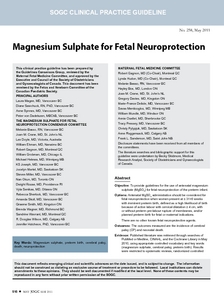Magee, LA; Sawchuck, D; Synnes, A; von Dadelszen, P
(2011)
SOGC Clinical Practice Guideline. Magnesium sulphate for fetal neuroprotection.
Journal of Obstetrics and Gynaecology Canada, 33 (5).
pp. 516-529.
ISSN 1701-2163
https://doi.org/10.1016/S1701-2163(16)34886-1
SGUL Authors: von Dadelszen, Peter
![[img]](https://openaccess.sgul.ac.uk/107535/1.hassmallThumbnailVersion/SOGC%20-%20Mg%20neuroprotection%20guidelines%20-%202011.pdf)  Preview |
|
PDF
Published Version
Available under License ["licenses_description_publisher" not defined].
Download (305kB)
| Preview
|
Abstract
OBJECTIVE: To provide guidelines for the use of antenatal magnesium sulphate (MgSO4) for fetal neuroprotection of the preterm infant. OPTIONS: Antenatal MgSO4 administration should be considered for fetal neuroprotection when women present at ≤ 31+6 weeks with imminent preterm birth, defined as a high likelihood of birth because of active labour with cervical dilatation ≥ 4 cm, with or without preterm pre-labour rupture of membranes, and/or planned preterm birth for fetal or maternal indications. There are no other known fetal neuroprotective agents. OUTCOMES: The outcomes measured are the incidence of cerebral palsy (CP) and neonatal death. EVIDENCE: Published literature was retrieved through searches of PubMed or Medline, CINAHL, and the Cochrane Library in May 2010, using appropriate controlled vocabulary and key words (magnesium sulphate, cerebral palsy, preterm birth). Results were restricted to systematic reviews, randomized controlled trials, and relevant observational studies. There were no date or language restrictions. Searches were updated on a regular basis and incorporated in the guideline to August 2010. Grey (unpublished) literature was identified through searching the websites of health technology assessment and health technology assessment-related agencies, clinical practice guideline collections, clinical trial registries, and national and international medical specialty societies. VALUES: The quality of evidence was rated using the criteria described in the Report of the Canadian Task Force on Preventive Health Care (Table 1). BENEFITS, HARMS, AND COSTS: Antenatal magnesium sulphate for fetal neuroprotection reduces the risk of "death or CP" (RR 0.85; 95% CI 0.74 to 0.98; 4 trials, 4446 infants), "death or moderate-severe CP" (RR 0.85; 95% CI 0.73 to 0.99; 3 trials, 4250 infants), "any CP" (RR 0.71; 95% CI 0.55 to 0.91; 4, trials, 4446 infants), "moderate-to-severe CP" (RR 0.60; 95% CI 0.43 to 0.84; 3 trials, 4250 infants), and "substantial gross motor dysfunction" (inability to walk without assistance) (RR 0.60; 95% CI 0.43 to 0.83; 3 trials, 4287 women) at 2 years of age. Results were consistent between trials and across the meta-analyses. There is no anticipated significant increase in health care-related costs, because women eligible to receive antenatal MgSO4 will be judged to have imminent preterm birth. VALIDATION: Australian National Clinical Practice Guidelines were published in March 2010 by the Antenatal Magnesium Sulphate for Neuroprotection Guideline Development Panel. Antenatal MgSO4 was recommended for fetal neuroprotection in the same dosage as recommended in these guidelines. However, MgSO4 was recommended only at < 30 weeks' gestation, based on 2 considerations. First, no one gestational age subgroup was considered to show a clear benefit. Second, in the face of uncertainty, the committee felt it was prudent to limit the impact of their clinical practice guidelines on resource allocation. Also in March 2010, the American College of Obstetricians and Gynecologists issued a Committee Opinion on MgSO4 for fetal neuroprotection. It stated that, "the available evidence suggests that magnesium sulphate given before anticipated early preterm birth reduces the risk of cerebral palsy in surviving infants." No official opinion was given on a gestational age cut-off, but it was recommended that physicians develop specific guidelines around the issues of inclusion criteria, dosage, concurrent tocolysis, and monitoring in accordance with one of the larger trials. SPONSORS: Canadian Institutes of Health Research (CIHR).
| Item Type: |
Article
|
| Additional Information: |
© 2011 Society of Obstetricians and Gynaecologists of Canada. Published by Elsevier Inc. All rights reserved. Made available with permission from the publisher. Contact publisher for any further re-use. |
| Keywords: |
Female, Humans, Infant, Newborn, Magnesium Sulfate, Neuroprotective Agents, Obstetric Labor, Premature, Pregnancy, Premature Birth, Tocolytic Agents, Humans, Premature Birth, Magnesium Sulfate, Tocolytic Agents, Neuroprotective Agents, Pregnancy, Infant, Newborn, Female, Obstetric Labor, Premature, 1114 Paediatrics And Reproductive Medicine |
| SGUL Research Institute / Research Centre: |
Academic Structure > Molecular and Clinical Sciences Research Institute (MCS) |
| Journal or Publication Title: |
Journal of Obstetrics and Gynaecology Canada |
| ISSN: |
1701-2163 |
| Language: |
eng |
| Publisher License: |
Publisher's own licence |
| PubMed ID: |
21639972 |
| Dates: |
| Date |
Event |
| 2011-05-01 |
Published |
|
 |
Go to PubMed abstract |
| URI: |
https://openaccess.sgul.ac.uk/id/eprint/107535 |
| Publisher's version: |
https://doi.org/10.1016/S1701-2163(16)34886-1 |
Statistics
Item downloaded times since 10 May 2016.
Actions (login required)
 |
Edit Item |



